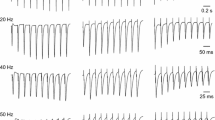Summary
-
1.
Entorhinal activation of the hippocampal cortex involves the sequential activation of a four-membered pathway: the perforant path from the entorhinal area — the mossy fibres from the dentate granule cells — the Schaffer collaterals of the CA3 pyramidal cells and finally, the CA1 pyramidal cell axons in the alveus.
-
2.
The spatial orientation of these four fibre bundles has been studied by recording the extracellular field potentials (population spike), signalling the discharge of neurones in response to orthodromic or antidromic impulses. The height of the population spike was taken as an indicator of the number of cells discharged (see the previous paper).
-
3.
The perforant path fibres from neighbouring parts of the entorhinal area run in a parallel fashion in a direction nearly transversely to the longitudinal axis of the hippocampus. In the dorsal part of the hippocampus, this direction was nearly sagittal, confirming Lømo (1971 a). The mossy fibres as well as the Schaffer collaterals and the alvear fibres were all found to run in the same direction. Thus, a point source of entorhinal activity projects its impulses through the four-membered pathway along a slice, or lamella, of hippocampal tissue oriented normally to the alvear surface and nearly sagittally in the dorsal part of the hippocampal formation. Also with more temporal locations of the stimulating and recording electrodes, the lamellar organization was maintained, but with a different orientation, matching the curving of the hippocampus so that the angle between the plane of the lamella and the longitudinal axis remained the same.
-
4.
By injection of a quick-setting solution of vinyl acetate, the direction of the arteries and veins in the hippocampal formation was displayed. The branches from the artery running in the hippocampal fissure are nearly straight and are oriented in a direction similar to that of the lamellae.
-
5.
The hippocampal cortex seems to be organized in parallel lamellae, both with regard to the neuronal and the vascular system. By means of this lamellar organization, small strips of the hippocampal cortex may operate as independent functional units, although excitatory and inhibitory transverse connections may modify the behaviour of the neighbouring lamellae.
Similar content being viewed by others
References
Andersen, P., Bliss, T.V.P., Lømo, T., Olsen, L.I., Skrede, K.K.: Lamellar organization of hippocampal excitatory pathways. Acta physiol. scand. 76, 4A-5A (1969).
—, Skrede, K.K.: Unit analysis of hippocampal population spikes. Exp. Brain Res. 13, 208–221 (1971).
—, Blackstad, T.W., Lømo, T.: Location and identification of excitatory synapses on hippocampal pyramidal cells. Exp. Brain Res. 1, 236–248 (1966).
—, Eccles, J.C., Løyning, Y.: Pathway of postsynaptic inhibition in the hippocampus. J. Neurophysiol. 27, 608–619 (1964).
—, Lømo, T.: Mode of activation of hippocampal pyramidal cells by excitatory synapses on dendrites. Exp. Brain Res. 2, 247–260 (1966).
—, Løyning, Y.: Interaction of various afferents on CA1 neurons and dentate granule cells. Coll. Int. C.N.R.S. No. 107, 23–45 (1962).
—, Holmqvist, B., Voorhoeve, P.E.: Excitatory synapses on hippocampal apical dendrites activated by entorhinal stimulation. Acta physiol. scand. 66, 461–472 (1966).
Blackstad, T.W., Brink, K., Hem, J., Jeune, B.: Distribution of hippocampal mossy fibers in the rat. An experimental study with silver impregnation methods. J. comp. Neurol. 138, 433–450 (1970).
Fujita, Y., Sakata, H.: Electrophysiological properties of CA1 and CA2 apical dendrites of rabbit hippocampus. J. Neurophysiol. 25, 209–222 (1962).
Hubel, D.H.: Tungsten mioroelectrode for recording from single units. Science 125, 549–550 (1957).
Lorente de Nó, R.: Studies on the structure of the cerebral cortex II. Continuation of the study of the Ammonic system. J. Psychol. Neurol. (Lpz.) 46, 113–177 (1934).
Lømo, T.: Patterns of activation in a monosynaptic cortical pathway: the perforant path input to the dentate area of the hippocampal formation. Exp. Brain Res. 12, 18–45 (1971 a).
—: Potentiation of monosynaptic EPSPs in the perforant path — dentate granule cell synapse. Exp. Brain Res. 12, 46–63 (1971 b).
Nilges, R.G.: The arteries of the mammalian cornuammonis. J.comp.Neurol. 80, 177–190 (1944).
Ramon y Cajal, S.: Über die feinere Struktur des Ammonshornes. Z. wiss. Zool. 56, 615–663 (1893).
—: Histologie du système nerveux de l'Homme et des Vertébrés. Paris, A. Maloine, 2, 993 pp. (1911).
Spencer, W.A., Kandel, E.R.: Hippocampal neuron responses to selective activation of recurrent collaterals of hippocampofugal axons. Exp. Neurol. 4, 149–161 (1961).
Woelcke, M.: Eine neue Methode der Markscheidenfärbung. J. Psychol. Neurol. (Lpz.), 51, 199–202 (1942).
Author information
Authors and Affiliations
Additional information
On special leave of absence from the Medical Research Council.
Rights and permissions
About this article
Cite this article
Andersen, P., Bliss, T.V.P. & Skrede, K.K. Lamellar organization of hippocampal excitatory pathways. Exp Brain Res 13, 222–238 (1971). https://doi.org/10.1007/BF00234087
Received:
Issue Date:
DOI: https://doi.org/10.1007/BF00234087




